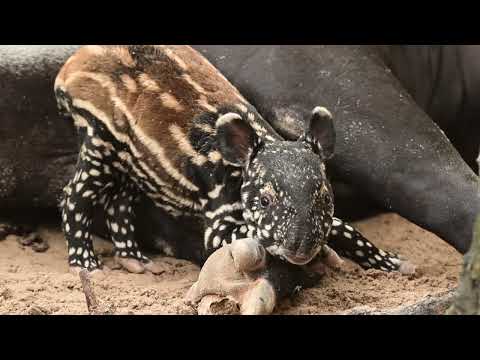On September 16th, after a gestation of approximately 13 months, an endangered Malayan tapir was born at Zoo Miami! This is the first successful birth of this species at the zoo in 18 years!
The 8-year-old mother’s name is Tengi, and she came to Zoo Miami from Zoo Tampa. This is her first viable offspring. Sadly, she had a still born calf in 2022. The 12-year-old father’s name is Kazu, and he arrived at Zoo Miami from the Point Defiance Zoo. This is his first offspring.
Sometimes weighing close to 800 pounds, Malayan tapirs are the largest of the four species of tapirs and the only species found in the Eastern Hemisphere. Using its long prehensile snout much like an elephant uses its trunk, this distant relative of the horse and rhinoceros is found around bodies of water in tropical forests of Thailand, Malaysia and Indonesia. Feeding on a variety of leaves, twigs, and fruits, it is an excellent swimmer and will often use its snout as a snorkel while also feeding on aquatic vegetation. They are primarily black with a large gray saddle that serves as a form of camouflage that helps disguise the body outline. Newborns and juveniles are dark brown with white stripes and spots to blend in with the dappled sunlight on the forest floor. The greatest threat to Malayan tapirs is the loss of habitat due to deforestation for agricultural palm oil plantations. They are also hunted for food in some communities.
A neonatal exam was done this morning by the Animal Health team. The exam allowed the team to establish baseline statistics so that they can ensure that the baby is developing normally. The newborn weighed 18.5 lbs. and was confirmed to be a male. He has been observed successfully nursing and initial indications are that he is healthy and thriving.
This was a carefully planned birth as part of the Species Survival Plan (SSP) managed through the Association of Zoos and Aquariums (AZA). This plan makes recommendations based on the genetic information of the parents with the goal of producing the healthiest and most genetically diverse offspring.
Mother and infant will remain off public view for an undetermined amount of time to ensure that they are able to properly bond with minimum distractions.
Video by: Ron Magill




